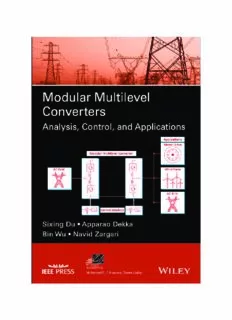
Modular Multilevel Converters: Analysis, Control, and Applications PDF
Preview Modular Multilevel Converters: Analysis, Control, and Applications
IEEEPress 445HoesLane Piscataway,NJ08854 IEEEPressEditorialBoard TariqSamad,EditorinChief GiancarloFortino XiaoouLi RayPerez DmitryGoldgof AndreasMolisch LindaShafer DonHeirman SaeidNahavandi MohammadShahidehpour EkramHossain JeffreyNanzer ZidongWang is available. ISBN: 978-1-119-36630-0 10 9 8 7 6 5 4 3 2 1 CONTENTS About the Authors xiii Preface xvii Acknowledgments xxi Acronyms xxiii Symbols xxvii About the Companion Website xli PART I GENERALASPECTSOFCONVENTIONALMMC 1 ReviewofHigh-PowerConverters 3 1.1 Introduction 3 1.2 OverviewofHigh-PowerConverters 4 1.3 VoltageSourceConverters 6 1.3.1 Neutral-PointClampedConverter 8 1.3.2 ActiveNeutral-PointClampedConverter 10 1.3.3 FlyingCapacitorConverter 11 1.3.4 NestedNeutral-PointClampedConverter 12 1.3.5 CascadedH-bridgeConverter 13 1.3.6 CascadedNeutral-PointClampedConverter 15 1.4 CurrentSourceConverters 16 1.4.1 Load-CommutatedCurrentSourceConverter 16 1.4.2 PWMCurrentSourceConverter 18 1.5 MatrixConverters 19 1.5.1 DirectMatrixConverter 19 1.5.2 IndirectMatrixConverter 20 1.5.3 Multi-ModularMatrixConverter 21 vii viii CONTENTS 1.6 ModularMultilevelConverters 23 1.6.1 ConverterTechnology 24 1.6.2 Applications 24 1.6.3 TechnicalChallenges 31 1.7 Summary 33 References 34 2 FundamentalsofModularMultilevelConverter 37 2.1 Introduction 37 2.2 ModularMultilevelConverter 38 2.2.1 ConverterCon guration 39 2.2.2 Con gurationofSubmodules 39 2.2.3 ComparisonofSubmodules 46 2.2.4 PrincipleofOperation 48 2.3 PulseWidthModulationSchemes 49 2.3.1 Phase-ShiftedCarrierModulation 51 2.3.2 Level-ShiftedCarrierModulation 59 2.3.3 SampledAverageModulation 60 2.3.4 SpaceVectorModulation 65 2.3.5 StaircaseModulation 73 2.4 Summary 77 References 77 3 ClassicalControlofModularMultilevelConverter 79 3.1 Introduction 79 3.2 OverviewofClassicalControlMethod 80 3.3 SubmoduleCapacitorVoltageControl 82 3.3.1 LegVoltageControl 82 3.3.2 VoltageBalanceStrategy 83 3.4 OutputCurrentControl 88 3.4.1 ReferenceFrameTheory 88 3.4.2 ControlofMMCwithPassiveLoad 92 3.5 CirculatingCurrentControl 95 3.5.1 MathematicalModel 96 3.5.2 ControlinSynchronous-dqReferenceFrame 97 3.5.3 ControlinStationary-abcReferenceFrame 100 3.6 Summary 101 References 101 CONTENTS ix 4 ModelPredictiveControlofModularMultilevelConverter 103 4.1 Introduction 103 4.2 MathematicalModelofMMC 105 4.2.1 Continuous-TimeModel 105 4.2.2 DiscretizationMethods 108 4.2.3 Discrete-TimeModel 110 4.3 ExtrapolationTechniques 113 4.3.1 VectorAngleExtrapolation 113 4.3.2 LagrangeExtrapolation 113 4.4 CostFunctionandWeightfactors 114 4.4.1 FormulationofCostFunction 114 4.4.2 SelectionofWeightFactors 116 4.5 DirectModelPredictiveControl 117 4.5.1 DesignProcedure 117 4.5.2 ControlAlgorithm 120 4.6 IndirectModelPredictiveControl 124 4.6.1 DesignProcedure 125 4.6.2 ControlAlgorithm 127 4.7 Summary 128 References 128 PART II ADVANCEDMODULARMULTILEVELCONVERTERS 5 PassiveCross-ConnectedModularMultilevelConverters 133 5.1 Introduction 133 5.2 PassiveCross-ConnectedMMC 134 5.2.1 Con gurationofPowerCircuit 134 5.2.2 SwitchingStatesandOutputVoltage 135 5.3 PrincipleofOperation 138 5.3.1 ModelingofPC-MMC 138 5.3.2 Phase-ShiftedCarrierModulationforPC-MMC 140 5.4 Low/ZeroFrequencyOperationofPC-MMC 144 5.4.1 EquivalentCircuit 145 5.4.2 DesignofCross-ConnectedCapacitor 146 5.4.3 SubmoduleCapacitorVoltageRipple 148 5.4.4 Common-ModeVoltage 151 5.5 ClassicalControlofPC-MMC 153 5.5.1 OutputCurrentControl 154
Description: